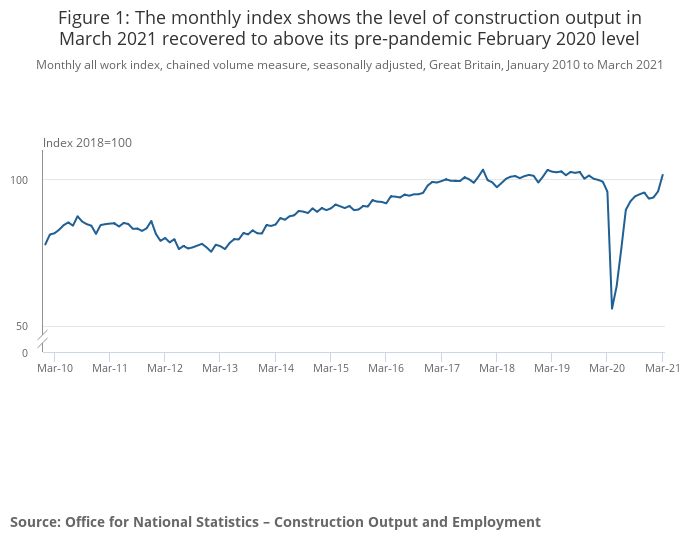Construction activity recovers to pre-pandemic levels
Output in the UK construction sector has officially recovered from its pandemic-forced plunge with new figures for March showing a 5.8% increase, led mostly by growth in both new work (6.7%) and repair and maintenance (4.4%).

Latest figures from the Office for National Statistics (ONS) found that construction output in March 2021 was 2.4% (£334 million) above the February 2020 pre-pandemic level; repair and maintenance work was 7.7% (£377m) above this level while new work was 0.5% (£44m) below.
Quarterly construction output grew by 2.6% in Quarter 1 (Jan to Mar) 2021 compared with Quarter 4 (Oct to Dec) 2020; this was driven by growth in both new work (2.8%) and repair and maintenance (2.2%).
New orders increased by 12.2% (£1,227m) in Quarter 1 2021 compared with Quarter 4 2020; this follows a fall of 7.8% (£848m) in Quarter 4 2020 but was 13.3% lower than Quarter 1 2020.
The annual rate of construction output price growth was 1.8% in March 2021.
Mark Robinson, group chief executive at SCAPE, said: “The continued growth in output reaffirms the construction industry’s resilience and ability to overcome the challenges it has faced over the last twelve months. Despite the ongoing concerns posed by materials and labour shortages, today’s figures indicate that the industry is continuing to help lead the economic recovery.
“The speed and scale of project delivery must now be our focus. Over the next few years, we have a real opportunity to accelerate public investment in sustainable, urban regeneration projects that will transform communities and improve the quality of people’s lives in a post-pandemic world. It’s crucial that projects are able to move through procurement quickly, so that we don’t lose momentum.”
Clive Docwra, managing director of property and construction consultancy McBains, said: “This is further proof of the construction sector’s continuing resurgence, with order books steadily being filled as confidence returns and the industry recovers from the downturn over the previous year. March represents the largest monthly growth since July 2020 when output grew by 17.8%. Private new housing has been a key driver, and a landmark has been reached with output now above pre-pandemic levels.
“One slight reservation is that while new contracts continue to come in, construction firms are being squeezed by soaring prices of imported materials, notably concrete, steel and timber. With margins already tight, the rising cost of raw materials threaten to negate any profit gains, so many construction firms remain on a knife-edge.
“These increasing costs also serve as a warning sign of global inflationary pressures, which could derail any sustained longer term growth.”
Fraser Johns, Beard financial director, added: “Within 24 hours of the Queen’s Speech outlining key government plans for training and skills, today’s output figures from the ONS serve to underline how crucial that is for the future.
“The construction industry has come through the biggest economic shock since the second world war, with continuing levels of growth getting us back to pre-pandemic levels in March.
“An increase in demand and confidence boosted by the vaccine rollout and a roadmap out the crisis has played its part. Now the challenge is to build on that success by ensuring we attract the talented professionals required to take our industry forward.
“But in the short term we also have a significant challenge to face in terms of materials shortages, which in many areas is verging on a crisis. As an industry we have to find ways to work around and plan ahead with supply chains to mitigate any serious delays, otherwise we’re in real danger of undermining our comeback from ground zero a year ago.”
Gareth Belsham, director of the national property consultancy and surveyors Naismiths, said: “Construction barely bothered with a bounce-back. It has jumped straight back into a boom.
“While March’s gravity-defying, 5.8% jump in output may grab the headlines, it’s the industry’s solid growth across the first quarter as a whole that is most encouraging.
“The £1bn, 2.6% expansion over the quarter would be impressive at any time. But coming at a time when the UK was under strict lockdown and all other sectors of the economy were shrinking, it’s a testament to the construction industry’s resilience and ability to incorporate socially distant ways of working.
“Crucially the future is looking brighter by the day too. £1.23bn of new orders poured in during the first quarter, and while this is still below the boomtime levels seen during 2020’s brief, pre-pandemic Boris bounce, it still reveals developers’ surging confidence and a good pipeline of work for builders.
“Private housebuilders are especially busy, with their activity now well past pre-pandemic levels and an incredible 166% up on their low point of last April.
“As the industry revels in full orderbooks and buoyant sentiment, there are growing pains as the mismatch between demand and supply leads material prices to surge.
“While this makes cost management more of a challenge, the combination of optimism, momentum and expansion is an intoxicating one – and the industry is gearing up for a sustained surge in demand as lockdown restrictions are rolled back further.”























